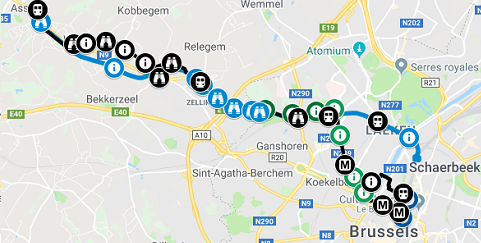
New section of the F212 cycle highway connects Zellik with the Brussels Region
On December 19 2018, an important section of the F212 cycle highway connecting Zellik with the Brussels Region was officially opened. When the entire F212 is completed, commuters can cycle from the municipality of Asse (32,000 inhabitants) via Asse industrial park and Zellik research park to Brussels.
Tucked between the Jette-Dendermonde railroad line and the N9 national road, the newly completed 2.5 km section of the F212 highway offers a pleasant and car-free route for those commuting between Asse and Brussels. The opening of this new section was attended by numerous stakeholders including representatives from the municipalities of Asse and Zellik, the province of Flemish-Brabant, Infrabel, Fietsersbond, NMBS, as well as Brussels’ Mobility Minister, Pascal Smet. After welcoming speeches, the many attendees got a chance to pedal along the high-quality cycling route themselves. Along the way, key features and major challenges of its construction were explained by Evert De Proost, engineer at the municipality of Asse and responsible for the work.
Key features include:
- 4-meter-wide bike path with lighting;
- grade-separated crossings under Vliegwezenlaan and the ring of Brussels;
- access ramps to the platform at the Zellik station; and
- reconstruction of the pedestrian and cycling bridge above the railroad and N9 national road to provide more comfortable slopes.
A crucial point on the new section is the stretch that passes under the ring of Brussels, which enables cyclists direct and safe passage to the Brussels Region. For this purpose, an existing railroad tunnel providing enough space for the cycle path was used. Determined to maintain at least 3 meters width, the pillars holding the overhead train lines were removed. They were instead replaced with steel beams attached directly to the wall on both sides of the tunnel thereby allowing an obstacle-free passage.
By providing this new connection, the F212 cycle highway cuts the distance between Zellik and Asse Industrial Park by one half. This particular section of the ring road is part of two trans-European (TEN-T) road corridors (Rhine – Alpine and North Sea – Mediterranean) and was previously unpassable for cyclists, requiring long detours. TEN-T roads often form a significant barrier for cycling traffic. The ECF is therefore working to ensure that the needs of cyclists - including sufficient density of safe and comfortable crossings - are considered already when such a road is built or reconstructed.
Apart from such technical challenges, the presence of a local snake (Ringslangen) at this particular stretch almost stopped the construction work. This forced the partners to undertake several measures in order to ensure that the cycle route did not disrupt the natural habitat of the snakes. Rather than building a wall between the N9 and the cycle highway, which would inhibit the snakes from moving across the area, a stone wall sloping down from the cycle path was made. Additionally, several small tunnels were created to make sure that the snakes could safely cross under the path.
Whilst the newly completed stretch of the F212 is a great achievement, construction work on the F212 is not yet done. In 2019, negotiations on stretches reaching in to both Brussels and those connecting the 2.5 km finished stretch in Asse with the one of Zellik will continue. Until the entire 14 km of the F212 has been completed, cyclists can consult this map where the black line suggests the best alternative routes on stretches where the cycle highway has not yet been completed.

More information about the F212 cycle highway can be found here.
Regions:
Network/Project Involved:
Contact the author
Recent news!
Upcoming events
Contact Us
Avenue des Arts, 7-8
Postal address: Rue de la Charité, 22
1210 Brussels, Belgium









